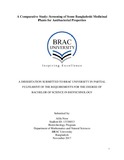A comparative study: screening of some Bangladeshi medicinal plants for antibacterial properties
Abstract
Medicinal plants are the plentiful bioresource of drugs for traditional medicines, food supplements, modern medicines, pharmaceutical intermediates, and chemical entities for synthetic drugs (Ishtiaq et al., 2013). Nowadays, researchers are increasingly turning their attention in investigating herbal products due to the increased resistance of microorganisms against the currently used antibiotics and pharmaceutical companies are searching for alternatives for the high cost of manufacture of synthetic drugs. Medicinal plants can be one approach to alleviate this situation as most of them are safe with slight side effects, if any, are of low cost and affect a wide range of antibiotic resistant microorganisms (Zahra et al., 2011). In the present study, ethanol, methanol and aqueous extracts of Curcuma longa, Zingiber officinale, Cinnamomum verum, Nigella sativa, Azadirachta indica and Mentha longifolia were subjected to microbial susceptibility assays using agar well diffusion method. The microorganisms employed were Bacillus cereus, Bacillus subtilis, Escherichia coli, Klebsiella pneumoniae, Salmonella typhi, Shigella flexneri, Staphylococcus aureus, Streptococcus pyogenes, Proteus vulgaris and Pseudomonas aeruginosa. The most susceptible microorganisms were Klebsiella pneumoniae and Staphylococcus aureus, while the least susceptible was Proteus vulgaris. Highest and remarkable antibacterial activity (zone of inhibition) was observed with methanolic extract of Black Cumin seeds against Klebsiella pneumoniae and Staphylococcus aureus (52mm and 35mm respectively). No antimicrobial activity was observed with aqueous extracts of all the six medicinal plants against the ten selected bacteria. Surprisingly, all the ten selected bacteria were susceptible to the ethanolic and methanolic extracts of only Cinnamon whereas the other five medicinal plant extracts did not show consistent antimicrobial activity against all the ten selected bacteria. However, the six standard antibiotic used as a positive control against each of the ten selected bacteria respectively had shown antimicrobial activity except Clindamycin against Streptococcus pyogenes and Cefoxitin against Shigella flexneri. Although Streptococcus pyogenes and Shigella flexneri were antibiotic resistant, but they were remarkably susceptible to the ethanolic and methanolic extracts of Cinnamon. The minimum inhibitory concentration (MIC) and minimum bactericidal concentration (MBC) of the methanolic extract of Black Cumin seeds against Klebsiella pneumoniae was found 34 mg/ml (MIC) and 44mg/ml (MBC) respectively. Thus, the findings of this study may provide the possibility of developing antibacterial supplements from these medicinal plants.

